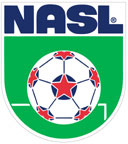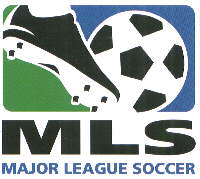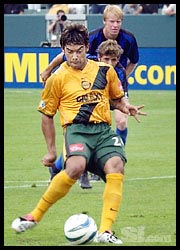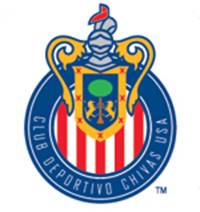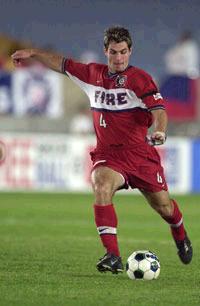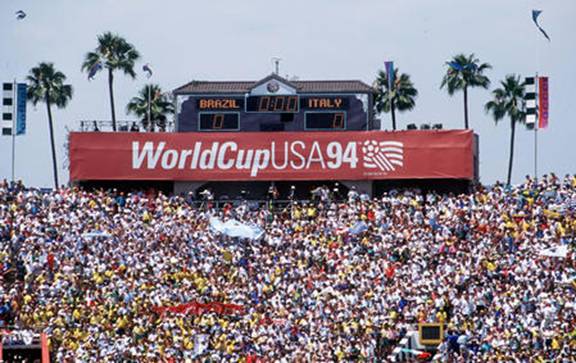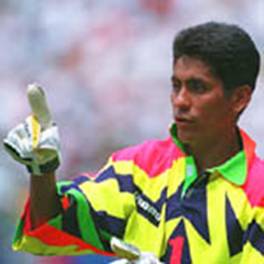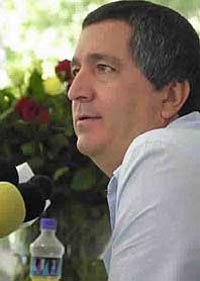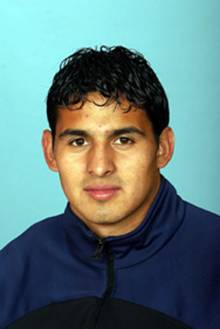Latinos in Soccer
Differences between Soccer and Baseball in the USA
USA Soccer
As mentioned in other pages, soccer still is not a mainstream sport in the United States . Foer explains in his book How Soccer Explains the World , Latino and Latino immigrants are the only people among the working class who care about soccer. Latino and Latino immigrants can be the ones to be “blamed” for any success soccer has had, has right now, and will ever have. This page will describe how Latinos (will)impact/ed such time periods.
Past:
The United States Soccer Federation was founded in 1913 as the United States Football Association. Since then, this country has been involved with soccer. It has participated in many world cups and even played in the semi-finals in the 1930 Uruguay World Cup—this country's best position ever in any World Cup. (14). The United State 's played in the next few World Cups, until the 1950's World Cup in Brasil. The USA would wait 40 more years to play in another world cup ( 16 ).
Yet, soccer died in popularity and only came back to the spotlight in the 1970's. The game had nearly been completely forgotten by then, but then Steven Ross, the president of Warner Communications, convinced Pelé to come and play in the North American Soccer League (NASL—no longer exists). There he played for a few years after his “official” retirement from Santos FC of Brasil for the New York Cosmos. There he signed a $4.5 million, 3 year contract (something unheard of at the time). Because of this, “Pelé has been one of the few names—and in most cases the only one—that Americans associate with soccer” ( 12 ). One interesting fact was the name of the professional soccer team of Los Angeles —The Los Angeles Aztecs, and obvious reference to the Latino community of the area.
Pelé and many other great players of the times helped create a powerful league—Even Pelé admitted that he liked the caliber of the league. The league included such famous players such as Franz Beckenbauer, Carlos Alberto, Steve Hunt, and Giorgio Chinaglia. Pelé and other famous players helped the league become incredibly popular—even filling arenas as large as the New York Giant's Arena; more than 75,000 people attended a soccer game. Eventually, and in the opinion of the authors of this site, sadly, the league died out. ( 16 ).
The next great moment in US soccer happened in 1994 with the World Cup being held in the United States . It was the first World Cup to be played in a non-Spanish or a non-Portuguese speaking country in the Americas . This was a big event, as many people from many different countries would be coming to the US to watch the biggest stars of the sport at the time—Romário, Roberto Baggio, Jorge Campos, Diego Maradona, and others. It is almost, if not more important than the Olympics in many countries. The person who led the battle for the World Cup to happen here was Pelé. He even asked the FIFA board to choose the United States to host the 1994 World Cup. ( 16 )
Yet, there were many people protested against the unfolding of this event. In a speech to Congress, ex-Buffallo Bills quarterback Jack Kamp said, “I think it is important for all those young out there, who someday hope to play real football, where you throw it and kick it and run with it and put in your hands, a distinction should be made the football is democratic, capitalism, whereas soccer is a European socialist [sport]”( 17 ). To this day there are people who protest soccer for it being too non-American: even if that means too Latin(o).
Two years after the World Cup, the United States Soccer Federation helped create the MLS- Major League Soccer ( 18 ). To ensure the MLS's success, they hired a Doug Logan as the CEO, president, and commissioner of the MLS. Logan is American of Cuban descent. Doug Logan decided to use a strategy to attract Hispanic and US-born Hispanics to the MLS. His plan seemed to work out. In 1997, 40% of all MLS fans were Hispanic . According to Logan “1.2 million fans are Hispanic, and they are the backbone of our league”. Logan was also involved in bringing in players such as Mexican goalkeeper Jorge Campos and Salvadoran Mauricio Cienfuegos to the L.A. Galaxy (large Mexican and Central American communities) and players such as Bolivian Marco Etcheverry to D.C. United (according to the article, D.C. has a “vibrant Bolivian Community”) He was planning on expanding the league to Miami and to try and capture the largest non-Hispanic Latino community: Brasilians/ Brasilian-Americans. He planned on bringing at least one Brasilian player for the team, but the idea never took off ( 19 ). To this day there is no Miami MLS team.
With time the MLS began to take off, and sponsors began to chase after the Latino stars. Jorge Campos even appeared in a Pepsi commercial with Salma Hayek! Part of MLS's success with Latinos involved the ticket price. While football and hockey games were around $40 a piece in 1997, MLS tickets were on average $13—much more accessible to the Latino community ( 19 )Over the years the MLS hired more and more Latino players and grew.
PRESENT:
Latinos continue to be important in soccer in the United States . Right now there are many Latino and Latin American soccer players in the MLS. The MLS website is available in both English and Spanish.
Let's take the Los Angeles Galaxy as an example of how big Latinos are in the MLS. They have 3 US-born Latinos: Midfielders Guillermo Gonzalez and Peter Vagenas, and defender Ryan Suarez . The assistant coach is Mexican-born, but naturalized American (Martin Vasquez). The head athletic director is US-born of Peruvian and Cuban descent (Ivan Pierra) ( 19 ). They also have three Latin America-born players:
- Midfielder Marcelo “Galo” Saragosa of São Paulo, Brasil. On loan from one of Brasil's top teams: São Paulo FC.
- Forward Carlos Ruiz of Guatemala City , Guatemala . Played for CSD Guatemala; voted among best players in the MLS.
- Forward Alejandro Moreno of Barquisimento , Venezuela . Went to college in the US : UNCG( 20 ).
Other teams follow similar patterns. They all have US or Latin America-born Latinos. Another example of how important Latinos still are in the league is that the number one goal scorer for the 2004 season: Amando Guevara of the Metrostars, born in Honduras .
Another proof that Latinos are very important to the US soccer scene is what happened in a World Cup qualifier match in 2001between the US and Honduras in Washington DC . Foer says a US victory in this game was essential to go onto the next round. People were loud, going so crazy that if the game had been played “in a country with lesser engineering standards, it would have been time to worry about a stadium collapse”. According to Foer, the game seemed like it was happening in Tegucigalpa . More people wore the blue-and-white Honduran jersey than the red American one ( 17 ).
The US national team also has many Latino players. The team line-up for the National team in a friendly game against Poland was:
USA: 13-Tim Howard; 6- Steve Cherundolo (3-Chris Albright, 46), 23-Eddie Pope, 4- Carlos Bocanegra , 15-Bobby Convey; 25- Pablo Mastroeni (9-Clint Mathis, 76), 5-Kerry Zavagnin (17-Eddie Gaven, 82), 10-Landon Donovan, 7-DaMarcus Beasley; 20-Brian McBride (capt.) (11-Brian Ching, 65), 16-Josh Wolff (8-Brian Mullan, 72), 14- Chris Armas
Names in bold are Latino Players
( 21 )
Latinos have a bright future in American soccer. In the opinion of one of the authors of this website, Latinos are the future of American soccer.
Future of Soccer
American soccer potentially has a bright future. There are many players right now that play as well as many international players. I believe Latinos will also have a very bright future in the US soccer scene.
The MLS is going through the process of expanding. Two new teams will be added to the league. The first one is Real Salt Lake —an obvious play on the great Spanish teams: Real Madrid, Real Betis, etc… They have not announced any Latino players for next year yet, but its quite likely that one or two will be added over the summer when the academic year is done and NCAA players become available.
The other team to make its way onto the soccer scene is The Club Deportivo Chivas USA . That was no mistake or typo. It is a team related to one of the most popular Mexican teams, Chivas de Guadalajara , Mexico . It is the most obvious attempt, yet, of the MLS to attract Latino fans—in this particular case, Mexicans and Chicanos.
This is a result of a failed attempt in the late 90's to engage Mexican-Americans in the league. According to Wahl, why would Mexicans and Chicanos watch a league with only a few Mexicans instead of the Mexican league games which they can see at home. Thus, Jorge Vergara (owner of the Dallas Mavericks), decided to create a branch of one of the most popular Mexican teams in the USA . And it seems that he will be successful in his goal. According to Vergara, there are “more than 10 million [registered] Chivas followers in this country” ( 18 ).
This should definitely bring in a larger following of Latinos to the MLS, particularly Mexicans and Chicanos. According to Chivas President, Ivan Sisniega, “Mexican-Americans haven't seen MLS as their own league because they don't have their own team. Now they will” ( 18 ).Now why was Chivas the chosen team? It could have something to do with the fact that they are famous for always being an all-Mexican team. It has never hired a single non-Mexican player in its 97-year history. It will be a very popular team ( 18 ).
It is obvious why he is investing in the US . His return will be very high. There are around 37 million Hispanics in the US . Around 85% of them are not from countries/heritages where Baseball is the more popular than soccer. Latinos from countries where soccer is “the sport” are truly fanatic about the game. They “hang mini soccer balls from their rearview mirrors like so many [hang] fuzzy dice” (18).
So how will they keep their all-Mexican identitity in a league with strict rules on how many foreigners there can be in a season per team? Chivas won't be completely Mexican. According to Vergara, “We may have some gringos, too” ( 18 ). Another thing they will be doing to ensure their “Mexican-ess” the coach will be Mexican ( 22 ). Vergara is creating a true team, with good players, who will be competing for the MLS title. They will be playing in the same stadium as the LA Galaxy, and will become their direct rivals. It will become quite profitable for Vergara, and in a way, for American soccer.
Other teams are also continuing with going after the Latino market by going after Latino players. For example, DC United has decided to try renewing Argentina midfielder Christian Gomez. (23). Possible Latino players showing up next season in the MLS include (currently) NCAA players: Stephen Arias, Aaron Lopez, Gonzalo Segares, Edwin Ruiz, Usiel Vasquez, and Orlando Ramirez.
